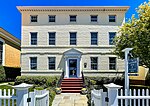Whitehorne House Museum
1811 establishments in Rhode IslandDecorative arts museums in the United StatesFederal architecture in Rhode IslandHistoric American Buildings Survey in Rhode IslandHistoric district contributing properties in Rhode Island ... and 10 more
Historic house museums in Rhode IslandHouses in Newport, Rhode IslandHouses on the National Register of Historic Places in Rhode IslandMuseums in Newport, Rhode IslandNRHP infobox with nocatNational Register of Historic Places in Newport, Rhode IslandNewport County, Rhode Island Registered Historic Place stubsNortheastern United States museum stubsRhode Island building and structure stubsUse mdy dates from August 2023

The Whitehorne House is an example of a United States Federal style mansions at 416 Thames Street in Newport, Rhode Island and is open to the public as a historic house museum.
Excerpt from the Wikipedia article Whitehorne House Museum (License: CC BY-SA 3.0, Authors, Images).Whitehorne House Museum
Thames Street, Newport
Geographical coordinates (GPS) Address Nearby Places Show on map
Geographical coordinates (GPS)
| Latitude | Longitude |
|---|---|
| N 41.481944444444 ° | E -71.314722222222 ° |
Address
Thames Street 415
02840 Newport
Rhode Island, United States
Open on Google Maps







